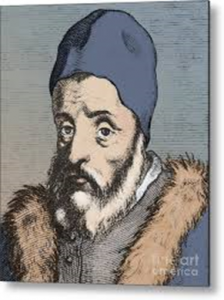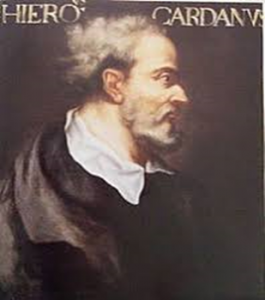Steve Brennan is a retired chest physician who worked for many years at the Northern General Hospital and came this morning to talk to us about the life of Gerolamo Cardano who lived in 16th century Italy and who has been described at various times as a physician, chemist, astrologer, astronomer, philosopher, mathematician, biologist and gambler. He certainly had a busy life.
He was born illegitimate in Pavia in 1501. His father was a lawyer who also had considerable expertise in mathematics and was an associate of Leonardo da Vinci. He initially assisted his father in his legal practice but left to read medicine at Pavia University much to his father’s disapproval.
When war broke out the university was forced to close so Cardano moved to Padua University where he proved to be an exceptional but outspoken and unpopular student. He was granted his doctorate in medicine at the third attempt in 1525 and applied for a position in the Milan College of Physicians but was turned down because he was illegitimate. He then moved to Sacco and set himself up in a small practice without any great success and had to rely on gambling to provide his income. In 1531 he married Lucia Bandarini and soon after moved to Milan and applied to the College of Physicians but was rejected again. This was a desperate period in his life he suffered from malaria, destitute and had to enter the poorhouse.
Cardano eventually obtained a post as lecturer in mathematics in Milan, was able to treat patients in his spare time and managed to establish a good reputation particularly amongst the nobility. He applied once more for entry to the Milan College without success probably due to his publishing a book entitled “The Differing Opinions of Physicians” attacking the medical establishment and highlighting no less than 76 errors commonly made by doctors. However, the book was popular with the public and following pressure from his admirers in 1539 he was accepted by the College. Over the next six years Cardano immersed himself in the study of mathematics culminating in the publishing of an opus which demonstrated the solution of the cubic equation.
Cardano’s fame spread due to the popularity of his published works and his growing reputation as a top physician. He received several offers from the crowned heads of Europe but turned them down apart from the Archbishop of St Andrews who suffered from debilitating asthma. The best medics in Europe were unsuccessful in treating him so Cardano, having been offered a huge sum of money, travelled to Scotland setting off in February 1552. His remedies for asthma were successful and many are still relevant today.
On returning to Italy he was appointed professor of medicine at Pavia University and acquired a portfolio of wealthy clients and celebrity status. However, in 1557 his son Giovanni married Brandonia di Seroni who was described as worthless and shameless. The marriage was a disaster and Giovanni eventually poisoned his wife, was tried and executed in 1560 and Cardano was devastated.
His reputation rapidly declined and he moved to Bologna as professor of medicine where due to his arrogance he was deeply unpopular.
In 1570 he was jailed for heresy, a result of the inquisition’s activities. Archbishop Hamilton interceded on his behalf and he was released in 1571. He decided to move to Rome where he was well received particularly by the Pope who granted him a pension. He died in September 1576 and was buried in Milan. Remarkably Cardano was credited with inventions such as the smokeless chimney, the multiple Archimedes screw, the gimbal compass stabiliser and an early version of the universal joint. This was a fascinating presentation about a brilliant but difficult man told with great style and good humour.


